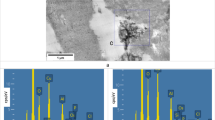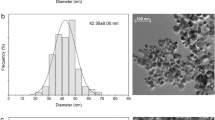Abstract
It has been demonstrated that inhaled fine (d < 2.5 μm) and ultrafine (d < 100 nm) particles produce more severe toxicity than coarse particles. Some recent data support the concept that the central nervous system (CNS) may be a target for the inhaled fine particulates. This work describes initial observation of the transport of intranasally instilled fine ferric oxide (Fe2O3) particles in animal brain. The iron micro-distribution and chemical state in the mice olfactory bulb and brain stem on day 14 after intranasal instillation of fine Fe2O3 particle (280 ± 80 nm) suspension at a single dose of 40 mg/kg body weight were analyzed by synchrotron radiation x-ray fluorescence and x-ray absorption near-edge structure (XANES). The micro-distribution map of iron in the olfactory bulb and brain stem shows an obvious increase of Fe contents in the olfactory nerve and the trigeminus of brain stem, suggesting that Fe2O3 particles were possibly transported via uptake by sensory nerve endings of the olfactory nerve and trigeminus. The XANES results indicate that the ratios of Fe (III)/Fe (II) were increased in the olfactory bulb and brain stem. The further histopathological observation showed that the neuron fatty degeneration occurred in the CA3 area of hippocampus. Such results imply an adverse impact of inhalation of fine Fe2O3 particles on CNS.





Similar content being viewed by others
References
Samet JM, Dominici FR, Curriero FCD, Coursac I, Zeger SL (2000) Fine particulate air pollution and mortality in 20 U.S. cities, 1987–1994. New Engl J Med 343:1742–1749
Katsouyanni K, Touloumi G, Spix C, Schwartz J, Balducci F, Medina S, Rossi G, Wojtyniak B, Sunyer J, Bacharova L, Schouten JP, Ponka A, Anderson HR (1997) Short-term effects of ambient sulphur dioxide and particulate matter on mortality in 12 European cities: results from the APHEA Project. Br Med J 314:1658–1663
Pope CA, Schwartz J, Ransom MR (1992) Daily mortality and PM10 pollution in Utah Valley. Arch Environ Health 47:211–217
Utell MJ, Frampton MW (2000) Acute health effects of ambient air pollution: the ultrafine particle hypothesis. J Aerosol Med 13:355–359
Peters A, Wichmann HE, Tuch T, Heinrich J, Heyder J (1997) Respiratory effects are associated with the number of ultrafine particles. Am J Respir Crit Care Med 155:1376–1383
Kreyling WG, Semmler M, Erbe F, Mayer P, Takenaka S, Schulz H, Oberdörster G, Ziesenis A (2002) Translocation of ultrafine insoluble iridium particles from lung epithelium to extrapulmonary organs is size dependent but very low. J Toxicol Environ Health 65(20):1513–1530
Kreyling WG, Semmler-Behnke M, Moller W (2006) Ultrafine particle lung interactions: does size matter? J Aerosol Med 19:74–83
Sunderman EW Jr (2001) Nasal toxicity, carcinogenicity, and olfactory uptake of metals. Ann Clin Lab Sci 31:3–22
Henriksson J, Tallkvist J, Tjälve H (1997) Uptake of nickel into the brain via olfactory neurons in rats. Toxicol Lett 91:153–162
Burd GD (1993) Morphologic study of the effects of intranasal zinc sulfate irrigation on the mouse olfactory epithelium and olfactory bulb. Microsc Res Tech 24:195–213
Oberdörster G, Sharp Z, Atudorei V, Elder A, Gelein R, Kreyling W, Cox C (2004) Translocation of inhaled ultrafine particles to the brain. Inhal Toxicol 16:437–445
DeLorenzo A (1970) The olfactory neuron and the blood–brain barrier. In: DeLorenzo A, Wolstenholme G, Knight J (eds) Taste and smell in vertebrates. CIBA Foundation Symposium Series. Churchill, London, pp 151–176
Korczynski RE (2000) Occupational health concerns in the welding industry. Appl Occup Environ Hyg 15:936–945
Thompson KJ, Shoham S, Connor JR (2001) Iron and neurodegenerative disorders. Brain Res Bull 55:155–164
Götz ME, Double K, Gerlach M, Youdim MBH, Riederer P (2004) The relevance of iron in the pathogenesis of Parkinson’s disease. Ann N Y Acad Sci 1012:193–208
Elder A, Gelein R, Silva V, Feikert T, Opanashuk L, Carter J, Potter R, Maynard A, Ito Y, Finkelstein J, Oberdörster G (2006) Translocation of inhaled ultrafine manganese oxide particles to the central nervous system. Environ Health Perspect 114:1172–1178
Rao DB, Wong BA, McManus BE, McElveen AM, James AR, Dorman DC (2003) Inhaled iron, unlike manganese, is not transported to the rat brain via the olfactory pathway. Toxicol Appl Pharmacol 193:116–126
Garcia-Verdugo JM, Llahi S, Farinas I, Martin V (1986) Laminar organization of the main olfactory bulb of Podarcis hispanica: an electron microscopic and Golgi study. J Hirnforsch 27:87–100
Holstege G, Kuypers HGJM, Dekker JJ (1977) The organization of the bulbar fiber connections to the trigeminal, facial and hypoglossal motor nuclei. II. An autoradiographic tracing study in the cat. Brain 100:265–286
Molavi DW (1997) Neuroscience tutorial, The Washington University School of Medicine Neuroscience Tutorial. Available from: http://thalamus.wustl.edu/course/
Huang YY, Li GC, He W, Wu YR (1997) The progress of Beijing Synchrotron Radiation X-ray fluorescence microprobe analysis. Final Report of Institute of High Energy Physics, pp 317–319
Bodian D, Howe HA (1941) The rate of progression of poliomyelitis virus in nerves. Bull Johns Hopkins Hosp 69:79–85
Hunter DD, Dey RD (1998) Identification and neuropeptide content of trigeminal neurons innervating the rat nasal epithelium. Neuroscience 83:591–599
Hunter DD, Undem BJ (1999) Identification of substance P content of vagal afferent neurons innervating the epithelium of the guinea pig trachea. Am J Respir Crit Care Med 159:1943–1948
Fechter LD, Johnson DL, Lynch RA (2002) The relationship of particle size to olfactory nerve uptake of non-soluble form of manganese into brain. Neurotoxicology 23:177–183
Lee BJ, Weiss ML, Mosier D, Chowdhury SI (1999) Spread of bovine herpesvirus type 5 (BHV-5) in the rabbit brain after intranasal inoculation. J Neurovirology 5:474–484
Gianutsos G, Morrow GR, Morris JB (1997) Accumulation of manganese in rat brain following intranasal administration. Fundam Appl Toxicol 37:102–105
Parvizi J, Damasio A (2001) Consciousness and the brainstem. Cognition 79:135–160
Schaefer ML, Bottger B, Silver WL, Finger TE (2002) Trigeminal collaterals in the nasal epithelium and olfactory bulb: a potential route for direct modulation of olfactory information by trigeminal stimuli. J Comp Neurol 444:221–226
Lewis J, Bench G, Myers O, Tinner B, Staines W, Barr E, Divine KK, Barrington W, Karlsson J (2005) Trigeminal uptake and clearance of inhaled manganese chloride in rats and mice. Neurotoxicology 26:113–123
Malecki EA, Devenyi AG, Beard JL, Cornor JR (1999) Existing and emerging mechanisms for transport of iron and manganese to the brain. J Neurosci Res 56:113–122
Moos T, Morgan EH (1998) Kinetics and distribution of [59Fe-125I]transferrin injected into the ventricular system of the rat. Brain Res 790:115–128
Longa SD, Pin S, Cortès R, Soldatov AV, Alpert B (1998) Fe-heme conformations in ferric myoglobin. Biophys J 75:3154–3162
Yoshida S, Ektessabi A, Fujisawa S (2001) XANES spectroscopy of a single neuron from a patient with Parkinson’s disease. J Synchrotron Radiat 8:998–1000
Acknowledgments
The authors are grateful to the foundation of National Basic Research Program of China (2006CB705605), the Chinese Academy of Sciences, and the National Natural Science Foundation of China (10490180, 20475055, 10675139).
Author information
Authors and Affiliations
Corresponding author
Rights and permissions
About this article
Cite this article
Wang, B., Feng, W.Y., Wang, M. et al. Transport of Intranasally Instilled Fine Fe2O3 Particles into the Brain: Micro-distribution, Chemical States, and Histopathological Observation. Biol Trace Elem Res 118, 233–243 (2007). https://doi.org/10.1007/s12011-007-0028-6
Received:
Revised:
Accepted:
Published:
Issue Date:
DOI: https://doi.org/10.1007/s12011-007-0028-6




